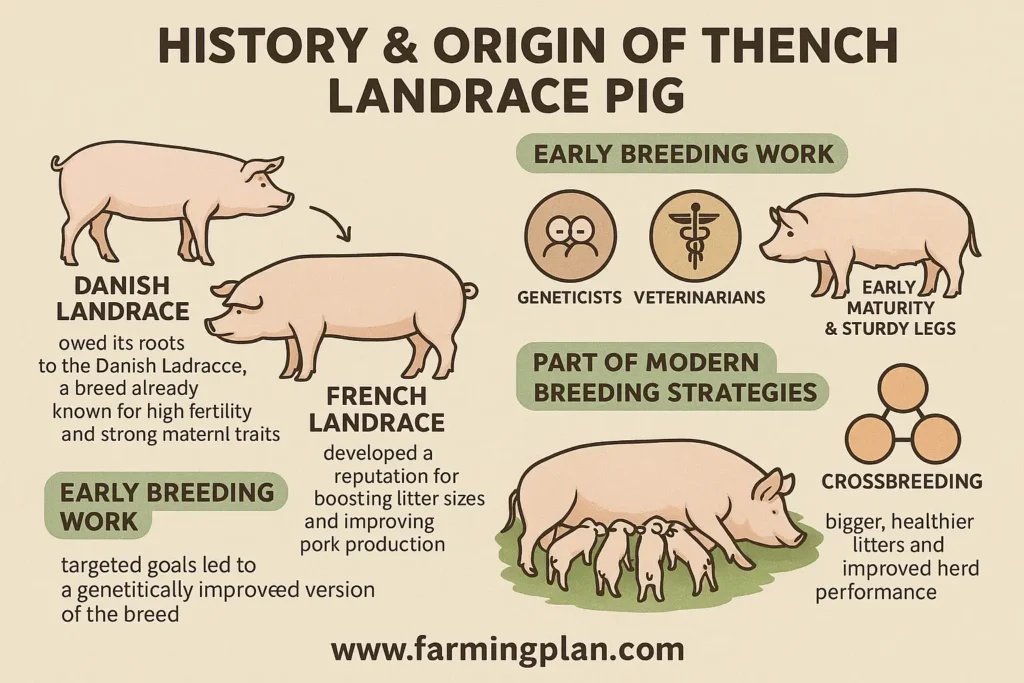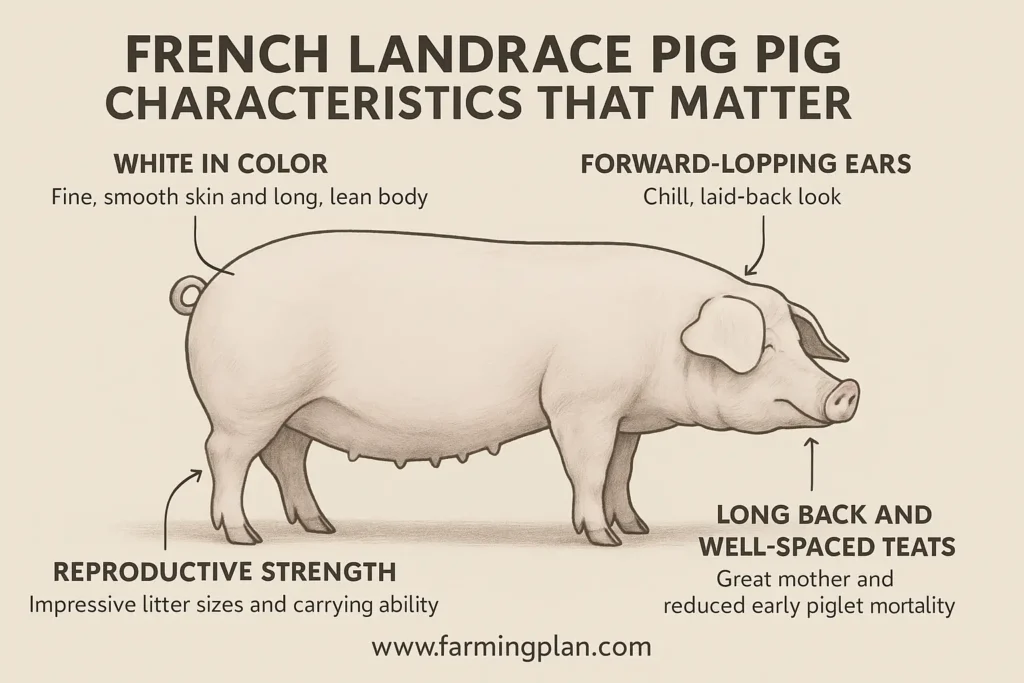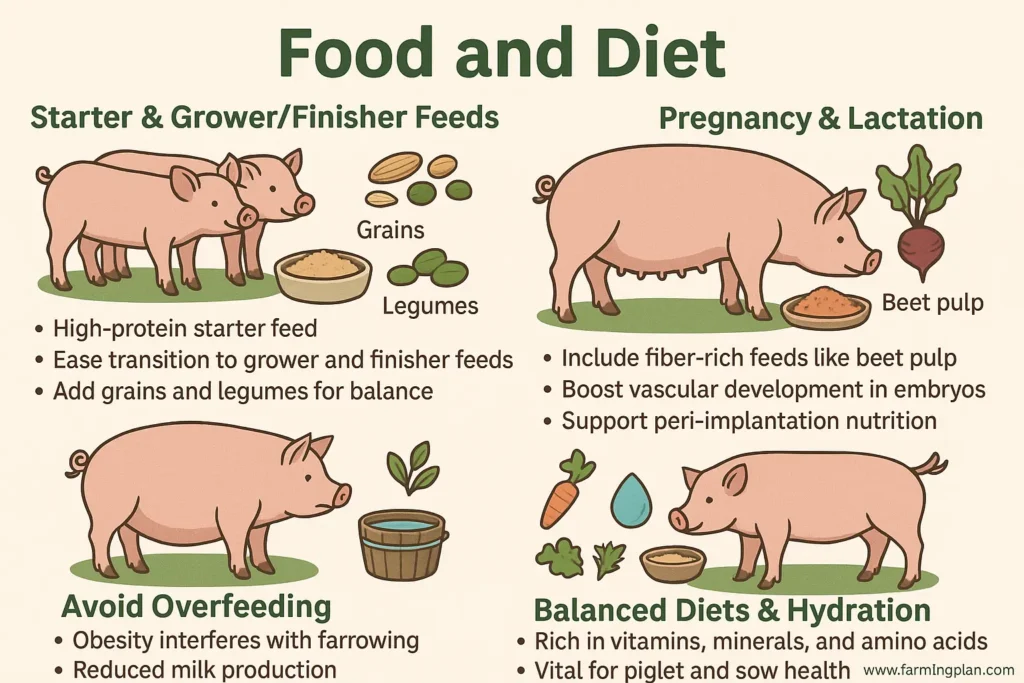If you’ve ever searched for a pig breed that checks every box, friendly, fertile, and farm-friendly, the French Landrace Pig might be your perfect match. I’ve raised different breeds over the years, but these pigs? They’ve become a cornerstone of my breeding program. The exceptional caring nature and large litter sizes of French Landrace pigs make them popular with breeders and in the commercial pig sector. Whether you have never owned a pig before or are an expert breeder, the return for your investment in this breed is consistently high. Today, I’ll walk you through everything from their history and temperament to feeding tips and expert tricks I’ve learned on the ground. Let’s dig in.

History & Origin of the French Landrace Pig
Let me take you back to where it all began. The French Landrace Pig owes its roots to the Danish Landrace, a breed already famous for high fertility and strong maternal traits. French breeders took these qualities and, with careful selection, began refining their own version of the breed. Over time, the French Landrace developed a reputation for boosting litter sizes and improving pork production, making it a hot favorite among European farmers.

In the early days, French breeding organisations worked closely with geneticists and veterinarians to identify the best traits. These included early maturity, sturdy legs, and strong reproductive performance. With targeted breeding goals, the French Landrace emerged as a genetically improved version of the original Danish stock, tailored for local conditions.
Today, it’s more than just a local favorite, it’s used widely in commercial pig cross populations and is part of modern breeding strategies worldwide. The goal? Bigger, healthier litters with improved overall herd performance. Trust me, it’s not just hype. I’ve seen firsthand how integrating French Landrace genetics can change the game on a small or large farm.
French Landrace Pig Characteristics That Matter
Let’s talk looks and features. These pigs are a sight to behold, white in color with fine, smooth skin and long, lean bodies. Their ears flop forward over their eyes, giving them a chill, laid-back look. But don’t let that fool you, they’re hard workers when it comes to breeding and mothering.
One thing that truly sets the French Landrace apart is its reproductive strength. Their litter sizes are impressive, and they carry those babies full term with fewer complications. This has a lot to do with genetics. In fact, studies show that these pigs carry beneficial quantitative trait loci (QTLs) related to fertility and litter size. I’ve seen pigs produce 12–14 piglets regularly with strong survival rates.

Another interesting characteristic is their body structure. Long backs, deep sides, and well-spaced teats make them great mothers. You’ll notice they’re built for nursing, which helps reduce early piglet mortality. These traits weren’t accidental, they came from decades of focused breeding and selecting for target traits that support both litter development and efficient meat production.
Temperament and Nature of French Landrace Pigs
You know how some pigs are just… difficult? Not the French Landrace. These pigs are easy-going and easy to handle, which makes a big difference when you’re checking sows daily or managing farrowing pens. I’ve had sows who practically leaned into belly rubs, and that calm nature matters when you’re working with a full barn.
They’re also social animals. If you raise them in groups, they interact well and rarely show signs of aggression. This makes them ideal for both small-scale farms and larger breeding setups. Less stress means better reproduction and stronger immune response, something many farmers overlook.
Read More: Aachen Cropper pigeon: is the rarest breed of pigeon in the world!
From a farmer’s perspective, temperament is money in the bank. The fewer the fights, the fewer injuries and the fewer vet bills. I always tell new breeders: if you want a pig that’s predictable, patient, and parent-minded, you won’t go wrong with the French Landrace. They’re the golden retrievers of the pig world, friendly, loyal, and built to please.
Food and Diet For French Landrace Pig
Feeding these pigs right is key to their health and reproductive success. I start my piglets on a high-protein starter feed that’s easy on their stomachs but gives them the energy to grow strong. As they age, I move them onto grower and finisher feeds, adding grains and legumes for balance.

For my breeding sows, I adjust their diet during pregnancy and lactation. I include fiber-rich feeds like beet pulp to aid digestion and boost vascular development in the growing embryos. During the peri-implantation phase, nutritional support is critical. I’ve seen how poor nutrition can lead to abnormal blood vessel development, which affects piglet survival rates.
Avoid overfeeding. Obese sows struggle with farrowing and often have poor milk production. My rule of thumb? Feed for function, not fat. Balanced diets rich in vitamins, minerals, and essential amino acids will do more for your sow than any fancy supplement. And always, always, provide clean, fresh water. Hydration affects everything from milk flow to metabolism.
How French Landrace Pigs Are Used in Farming
The main reason farmers love this breed? Reproduction. They are known for producing lots of strong and healthy piglets. Producers in commercial sow groups have used them to help increase herd uniformity and make all litters about the same size.
Read More: Lacombe Pig: Pig From Canada’s Dairyland
But that’s not all. French Landrace pigs also play a key role in commercial pig cross populations. They’re often bred with terminal sire lines to balance out traits like muscle growth and feed conversion. That means better meat yield without sacrificing sow productivity.
I’ve even met small farmers who raise them purely for show or breeding stock. Their calm nature, tidy appearance, and strong mothering instincts make them stand out in exhibitions. Whether you’re breeding for market hogs or want to elevate your herd’s genetics, this breed earns its keep and then some.
Special Traits That Set French Landrace Pigs Apart
What makes these pigs so amazing? I’d like to address litter size next. One of the sows I had gave birth to 16 piglets at once, but it wasn’t a lucky accident. Thanks to their special genes, their litters are usually big and I’ve observed this in my own breeding.
Second, their adaptability. Whether it’s cold winters or hot summers, French Landrace pigs handle environmental stress better than many other breeds. This makes them ideal for farms in varied climates.
Lastly, they’re part of ongoing research projects. Their DNA is included in the pig genome sequence used to study population stratification, polymorphisms, and even future applications in genomic selection. If you want a pig that’s not just surviving, but driving future farming tech, this is the breed.
Health Problems and How I Keep Mine Healthy
Sure, no breed is totally problem-free. But the French Landrace doesn’t come with a long list of issues. The most common problems I’ve seen are respiratory infections and minor hoof issues, usually tied to poor bedding or dusty environments.
I keep barns ventilated and dry, and I rotate pens every few weeks. For respiratory health, vaccinations are essential. I also monitor for signs of sluggish behavior, coughing, or appetite loss, early detection saves time and money.
Genetically, some pigs may carry traits linked to non-additive effects or negative effects on fertility. This is why I always buy from trusted breeders who understand breeding values. Health begins with good genetics. You can’t outfeed or out-medicate poor breeding.
Step-by-Step Farming Guide
Step 1: Set Up Proper Housing
Good housing is non-negotiable. I use well-ventilated pens with non-slip flooring and clean straw bedding. Temperature control is vital, especially for piglets. Heat lamps are your best friend in the early weeks.
Step 2: Choose Healthy Piglets
Always start with piglets from certified breeders. Look for clean eyes, straight legs, and active movement. Ask for litter records, and don’t be shy about checking the sow’s past breeding values.
Step 3: Feed Based on Growth Stage
From starter feeds to lactation diets, match feed types to pig age and purpose. I add fiber and protein supplements during pregnancy to support fetal embryonic development and sow health.
Step 4: Maintain Cleanliness and Routine
I clean pens daily, sanitize feeding troughs, and change bedding twice a week. It’s labor, sure, but clean pigs are healthy pigs. Plus, the daily routine helps you spot issues early.
Step 5: Monitor Breeding Cycles and Farrowing
Track sow heat cycles. I favor using boars that have shown stable good qualities. Planning work well in advance helps you prepare good nutrition and lessen any difficulties after your pet gives birth.
Step 6: Record Everything
I keep detailed logs, litter sizes, feed rations, weight gains. These records help me make smart breeding decisions and improve outcomes season after season.
Expert Tips & Best Practices for Raising French Landrace Pigs
Here’s what’s worked for me:
- Never breed a sow that had less than 10 healthy piglets in her first litter.
- Use data-driven tools to select for traits tied to genome-wide significance, they often lead to better long-term gains.
- Work with breeding organisations that invest in genomic tools to avoid inherited problems and improve breeding goals.
Smart breeding begins with the French Landrace, big litters, calm nature, great value.
Where To Buy French Landrace Pigs
When buying, go straight to recognized pig breeding organisations. In Europe, groups like France Génétique Porcine maintain high standards. In the U.S., try the National Swine Registry for registered suppliers.
Prices for French Landrace pigs vary based on age and genetics. Expect to pay more for pigs with proven fertility or known litter sizes. I once paid a premium for a sow who’d farrowed 15 piglets per litter, best money I ever spent.
Always ask breeders for:
- Genomic profiles
- Breeding history
- Health certifications
- Don’t settle for less.
FAQ
What is the average litter size of a French Landrace pig?
Most sows produce between 10–14 piglets per litter, with some reaching up to 16 in high-performance lines.
Are French Landrace pigs good for first-time farmers?
Yes, they’re calm, easy to manage, and have strong maternal instincts, great for beginners.
How much does a French Landrace pig cost?
Prices vary from $300 to $800 based on age, litter performance, and breeding history.
Can French Landrace pigs be raised in hot climates?
Absolutely. With good ventilation and hydration, they adapt well to various environments.
What’s the scientific name for French Landrace pigs?
They belong to Sus scrofa domesticus, like all domestic pigs.
Conclusion
Farming French Landrace pigs has been one of the most gratifying things for me. Because they have good temperaments, solid reproductive abilities and can easily adjust, they are a wise pick for breeders, farmers and smallholders. If pigs are cared for well, fed properly and bred thoughtfully, they can boost your farm’s profits and supply you with healthy livestock over the years. Whether you’re in it for crossbreeding, pork production, or just good genetics, trust me, this breed delivers.

